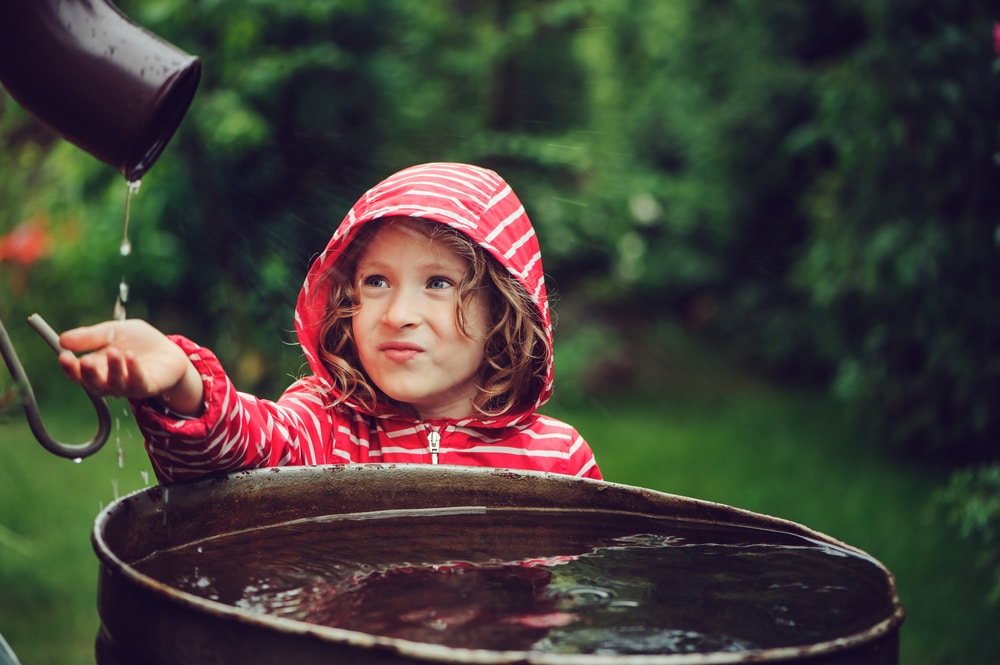Rain Barrels: 101
In the lush landscapes of Illinois, harnessing rainwater is both a practical and an eco-friendly endeavor.
Rain barrels offer you an efficient way to collect and recycle rainwater for your garden needs.
Definition and Purpose
Rain Barrels are water storage containers designed to collect and store rainwater, typically from your house’s roof via downspouts.
Their main purpose is to conserve water and reduce runoff, which can be particularly beneficial during dry spells.
Collected rainwater can be used for watering your garden, washing cars, and other outdoor water-related tasks where potable water isn’t necessary.
- Capacity: Range from approximately 15 to 5,000 gallons
- Components: Include a spigot for hose attachment, overflow valve, and a mesh screen to keep out debris and insects
Historical Use in Illinois
In Illinois, the use of rain barrels harks back to when early settlers recognized the value of rainwater for agriculture and household uses.
Over time, advances in technology and water infrastructure diminished their use, but with growing environmental awareness, rain barrels have seen a resurgence as a sustainable water management solution.
- Past: Essential for water collection before modern plumbing
- Present: Part of the broader approach to ‘rainscaping’ and sustainable gardening practices.
Environmental Advantages
When you integrate rain barrels into your Illinois garden, you embrace a host of environmental advantages. Not only are you conserving a vital resource, but you’re also playing a critical role in reducing adverse runoff effects and nurturing a diverse ecosystem.
Water Conservation
By harvesting rainwater, you effectively lessen the demand on municipal water supplies.
Illinois receives an average annual precipitation of about 38 inches.
Utilizing rain barrels allows you to capture this generous rainfall, particularly during thunderstorms, translating into substantial water savings.
Consider this: a single inch of rain on a 1,000 square-foot roof can yield approximately 600 gallons of water.
This is water that can sustain your garden, especially during dry spells, reducing the need to utilize treated tap water.
Reducing Stormwater Runoff
The use of rain barrels has a pronounced impact on stormwater management.
During heavy downpours, water that falls on impermeable surfaces, such as your home’s roof, flows into storm drains, potentially carrying with it pollutants like pesticides and fertilizers.
By capturing rainwater, you’re intercepting this flow, thereby minimizing contamination that reaches rivers and streams.
- Reduction in Runoff: Mitigates local flooding risks.
- Cleaner Water Bodies: Decreases the amount of pollutants reaching natural waters.
- Soil Erosion Control: Less water runoff means reduced soil displacement.
Promoting Biodiversity
Rain barrels contribute to the creation of a more biodiverse garden in Illinois.
Rainwater is often the preferred source of hydration for plants because it is devoid of chlorine and has a balanced pH.
A well-watered garden becomes a haven for various species, from birds to beneficial insects and amphibians.
- Healthier Plants: Nutrient-rich rainwater leads to more vigorous growth.
- Wildlife Attraction: Provides a vibrant ecosystem for local wildlife.
- Natural Pest Control: Encourages the presence of predator insects to manage pest populations.
Garden Benefits
In Illinois gardens, rain barrels offer you notable advantages for plant vitality and soil integrity. Grasping these benefits will enable you to cultivate a more robust and environmentally friendly garden.
Improving Plant Health
Key Nutrients: Your plants will relish rainwater as it is naturally oxygenated, and being free of chlorine and salts found in tap water, is gentler on the plant’s cellular structures.
Essential trace nutrients, which rainwater contains, are a boon for facilitating robust growth.
- Optimal Growth: Rainwater’s ambient temperature and pH level are often more aligned with plants’ needs compared to tap water. This alignment is pivotal for preventing shock in sensitive plants, promoting stronger and healthier growth patterns.
Soil Erosion Prevention
- Water Dispersal: Utilizing a rain barrel can mitigate the impact of heavy downpours that may lead to soil erosion.
- Soil Structure: By capturing rainwater, you control its flow in the garden, allowing you to release water slowly and evenly, which helps maintain soil structure and health.
Soil Structure: Healthy soil is crucial for your plants, and by preventing erosion, the soil retains its layers and nutrients.
This preservation of topsoil not only supports your plants but also enables microorganisms within the soil to thrive, further enhancing plant health and growth.
Cost Savings and Efficiency
Implementing rain barrels in your Illinois garden can lead to significant cost savings and boost the efficiency of your water usage. Careful planning can maximize these benefits to ensure you get the most out of every drop collected.
Reduction in Water Bills
By using a rain barrel, you can lower your water bills significantly. Here’s how:
- Catchment Area: A standard catchment area on your property can yield considerable amounts of water. For every inch of rain that falls on 1,000 square feet of roof, you can collect approximately 600 gallons of water.
- Usage: The water you collect can directly irrigate your garden, reducing your reliance on municipally supplied water.
- Efficiency: Optimal use involves waiting for at least 2 dry days before utilizing the stored water, ensuring you have a supply during dry spells.
Long-Term Garden Sustainability
Rain barrels contribute to sustainable gardening practices in several ways:
- Water Conservation: During periods of drought, which are not uncommon in Illinois, you’ll have a reserve of water that can be critical for plant health.
- Reducing Runoff: Using rain barrels can lead to reducing stormwater runoff, which can carry pollutants into local water systems.
- Diligent Maintenance: Ensure a 90% harvest efficiency by keeping your guttering and rain barrels in good repair to minimize leaks and maximize collection.
Installation and Maintenance
Proper installation and regular maintenance of your rain barrel will ensure you get the most out of this garden enhancement. It’s important to select the correct barrel, set it up according to best practices, and perform routine checks and cleaning.
Choosing the Right Rain Barrel
When deciding on a rain barrel for your garden, consider the following factors:
- Capacity: Most rain barrels range from 15 to 80 gallons. Larger systems like cisterns can hold up to 5,000 gallons.
- Material: Options include plastic, wood, or metal. Plastic rain barrels are lightweight and affordable, while wooden ones can be more aesthetically pleasing.
- Features: Look for a barrel with a spigot for easy access to water, a mesh screen to prevent debris and mosquitoes, and an overflow valve.
A wise selection caters to the size of your garden and personal preferences in maintenance and aesthetics.
Setup Best Practices
To ensure your rain barrel functions efficiently:
- Choose a Location: Next to a downspout with ample space is ideal.
- Elevate Your Barrel: Use bricks or a stand to raise it, which will increase water pressure and make it easier to fill watering cans.
- Secure Connections: Attach your rain barrel to the downspout using a diverter or secure fitting.
- Prevent Overflows: Attach an overflow hose to direct excess water away from your home’s foundation.
Ongoing Care and Troubleshooting
Maintain your rain barrel with the following steps:
- Regular Cleaning: Empty and wash your barrel to remove algae and debris every few months or as needed.
- Inspect for Leaks: Check connections seasonally and repair any leaks to prevent water waste.
- Winterize: If you live in an area with freezing temperatures, drain your barrel and store it or cover it during winter.
Frequently Asked Questions
Rain barrels are a smart addition to any Illinois garden, designed to conserve water and manage stormwater. Below, your most pressing inquiries about these systems are directly addressed.
How do rain barrels contribute to sustainable gardening in Illinois?
Rain barrels help in creating sustainable gardens by capturing rainwater from your roof, which can then be reused for watering plants and lawns. This reduces the need for treated tap water and taps into Illinois’ variable rainfall.
What are the primary advantages of incorporating rain barrels in residential landscapes?
The main benefits of using rain barrels include reducing water bills, lessening the demand on municipal systems during peak watering periods, and providing your plants with untreated water, which is often better for plant health due to the lack of chlorine and fluoride.
Are there any considerations or drawbacks to be aware of when using rain barrels in gardening?
One consideration is the potential for standing water to attract mosquitoes. Utilizing a rain barrel with a tight-fitting lid and a screen can mitigate this risk.
Additionally, during heavy rainfalls, barrels can overflow; thus, a well-thought-out overflow mechanism is essential.
Can water collected in rain barrels be used for irrigating edible plants?
Yes, water from rain barrels can irrigate edible plants. However, it’s essential to avoid using water that has run off from asphalt shingles or treated wood, as it may contain chemicals that could be harmful if ingested.
What role do rain barrels play in stormwater management within Illinois communities?
Rain barrels reduce stormwater runoff, which can carry pollutants into local waterways. By capturing rainwater, you’re helping to lower the risk of flooding and water pollution, contributing positively to your community’s eco-system.
How does the use of rain barrels align with Illinois’ water conservation efforts?
Using rain barrels supports Illinois’ goals for water conservation by reducing the demand for potable water for non-potable uses. It also preserves the state’s water resources and encourages residents to be active participants in water stewardship.


